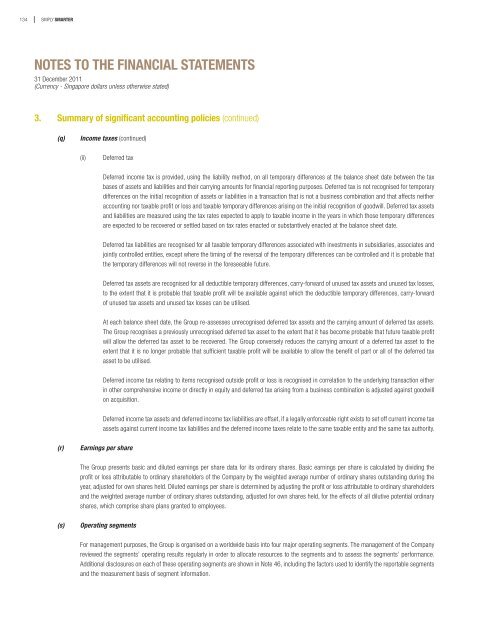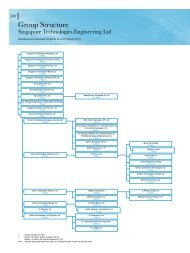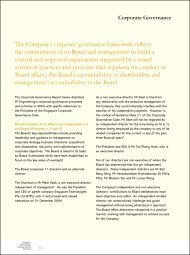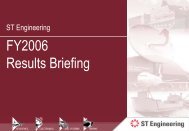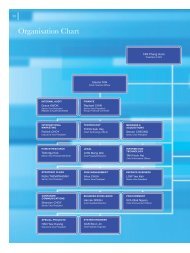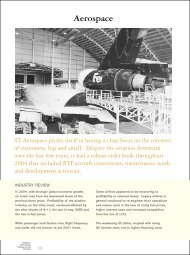notes to the financial statements - Singapore Technologies ...
notes to the financial statements - Singapore Technologies ...
notes to the financial statements - Singapore Technologies ...
Create successful ePaper yourself
Turn your PDF publications into a flip-book with our unique Google optimized e-Paper software.
134 SIMPLY SMARTERNOTES TO THE FINANCIAL STATEMENTS31 December 2011(Currency - <strong>Singapore</strong> dollars unless o<strong>the</strong>rwise stated)3. Summary of significant accounting policies (continued)(q)Income taxes (continued)(ii)Deferred taxDeferred income tax is provided, using <strong>the</strong> liability method, on all temporary differences at <strong>the</strong> balance sheet date between <strong>the</strong> taxbases of assets and liabilities and <strong>the</strong>ir carrying amounts for <strong>financial</strong> reporting purposes. Deferred tax is not recognised for temporarydifferences on <strong>the</strong> initial recognition of assets or liabilities in a transaction that is not a business combination and that affects nei<strong>the</strong>raccounting nor taxable profit or loss and taxable temporary differences arising on <strong>the</strong> initial recognition of goodwill. Deferred tax assetsand liabilities are measured using <strong>the</strong> tax rates expected <strong>to</strong> apply <strong>to</strong> taxable income in <strong>the</strong> years in which those temporary differencesare expected <strong>to</strong> be recovered or settled based on tax rates enacted or substantively enacted at <strong>the</strong> balance sheet date.Deferred tax liabilities are recognised for all taxable temporary differences associated with investments in subsidiaries, associates andjointly controlled entities, except where <strong>the</strong> timing of <strong>the</strong> reversal of <strong>the</strong> temporary differences can be controlled and it is probable that<strong>the</strong> temporary differences will not reverse in <strong>the</strong> foreseeable future.Deferred tax assets are recognised for all deductible temporary differences, carry-forward of unused tax assets and unused tax losses,<strong>to</strong> <strong>the</strong> extent that it is probable that taxable profit will be available against which <strong>the</strong> deductible temporary differences, carry-forwardof unused tax assets and unused tax losses can be utilised.At each balance sheet date, <strong>the</strong> Group re-assesses unrecognised deferred tax assets and <strong>the</strong> carrying amount of deferred tax assets.The Group recognises a previously unrecognised deferred tax asset <strong>to</strong> <strong>the</strong> extent that it has become probable that future taxable profitwill allow <strong>the</strong> deferred tax asset <strong>to</strong> be recovered. The Group conversely reduces <strong>the</strong> carrying amount of a deferred tax asset <strong>to</strong> <strong>the</strong>extent that it is no longer probable that sufficient taxable profit will be available <strong>to</strong> allow <strong>the</strong> benefit of part or all of <strong>the</strong> deferred taxasset <strong>to</strong> be utilised.Deferred income tax relating <strong>to</strong> items recognised outside profit or loss is recognised in correlation <strong>to</strong> <strong>the</strong> underlying transaction ei<strong>the</strong>rin o<strong>the</strong>r comprehensive income or directly in equity and deferred tax arising from a business combination is adjusted against goodwillon acquisition.Deferred income tax assets and deferred income tax liabilities are offset, if a legally enforceable right exists <strong>to</strong> set off current income taxassets against current income tax liabilities and <strong>the</strong> deferred income taxes relate <strong>to</strong> <strong>the</strong> same taxable entity and <strong>the</strong> same tax authority.(r)Earnings per shareThe Group presents basic and diluted earnings per share data for its ordinary shares. Basic earnings per share is calculated by dividing <strong>the</strong>profit or loss attributable <strong>to</strong> ordinary shareholders of <strong>the</strong> Company by <strong>the</strong> weighted average number of ordinary shares outstanding during <strong>the</strong>year, adjusted for own shares held. Diluted earnings per share is determined by adjusting <strong>the</strong> profit or loss attributable <strong>to</strong> ordinary shareholdersand <strong>the</strong> weighted average number of ordinary shares outstanding, adjusted for own shares held, for <strong>the</strong> effects of all dilutive potential ordinaryshares, which comprise share plans granted <strong>to</strong> employees.(s)Operating segmentsFor management purposes, <strong>the</strong> Group is organised on a worldwide basis in<strong>to</strong> four major operating segments. The management of <strong>the</strong> Companyreviewed <strong>the</strong> segments’ operating results regularly in order <strong>to</strong> allocate resources <strong>to</strong> <strong>the</strong> segments and <strong>to</strong> assess <strong>the</strong> segments’ performance.Additional disclosures on each of <strong>the</strong>se operating segments are shown in Note 46, including <strong>the</strong> fac<strong>to</strong>rs used <strong>to</strong> identify <strong>the</strong> reportable segmentsand <strong>the</strong> measurement basis of segment information.


